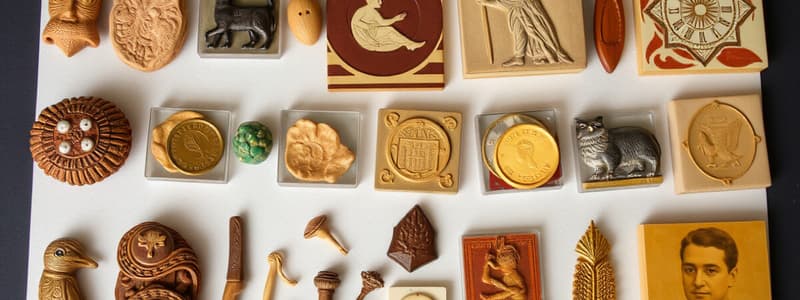Podcast
Questions and Answers
What are the differences between class and individual characteristics of evidence?
What are the differences between class and individual characteristics of evidence?
Class characteristics allow an item to be compared with a group and are useful for elimination, while individual characteristics can be compared to a specific item and are useful for identification.
Which method for DNA analysis is best for individualization in forensic work and why?
Which method for DNA analysis is best for individualization in forensic work and why?
STR is the best method because it produces full profiles from small, degraded samples and is highly discriminating.
How is tape used to collect hair and fiber evidence at the crime scene?
How is tape used to collect hair and fiber evidence at the crime scene?
Adhesive tape is applied to an area to lift fibers and is affixed to a transparent backer.
When evaluating glass fractures for direction of force, which fragments can be used?
When evaluating glass fractures for direction of force, which fragments can be used?
How is paint layering used to differentiate two paint samples?
How is paint layering used to differentiate two paint samples?
Which environmental variations are significant when comparing soil samples?
Which environmental variations are significant when comparing soil samples?
How does evaluating evidence involving a pistol differ from that involving a revolver?
How does evaluating evidence involving a pistol differ from that involving a revolver?
What two manufactured components of a barrel does rifling refer to?
What two manufactured components of a barrel does rifling refer to?
How are bullets marked for evidence and packaged?
How are bullets marked for evidence and packaged?
Which method of collecting tool mark evidence is better and why?
Which method of collecting tool mark evidence is better and why?
What is the most significant class characteristic in shoe mark examinations?
What is the most significant class characteristic in shoe mark examinations?
What type of containers are used to collect fire scene evidence with suspected accelerants?
What type of containers are used to collect fire scene evidence with suspected accelerants?
What three things must an investigator know before searching for evidence?
What three things must an investigator know before searching for evidence?
What is Locard's Exchange Principle?
What is Locard's Exchange Principle?
How does cross-contamination occur and with what types of evidence?
How does cross-contamination occur and with what types of evidence?
Describe class characteristics.
Describe class characteristics.
Describe individual characteristics.
Describe individual characteristics.
What is a mechanical fit/fracture match and is it individual or class evidence?
What is a mechanical fit/fracture match and is it individual or class evidence?
How can fingerprint evidence be used and what types of characteristics are employed?
How can fingerprint evidence be used and what types of characteristics are employed?
Give examples of a class-level serology test and an individual-level serology test.
Give examples of a class-level serology test and an individual-level serology test.
What can be discerned from hair evidence?
What can be discerned from hair evidence?
When should hair and fiber evidence be collected?
When should hair and fiber evidence be collected?
Which technique is quickly replacing microscopic hair comparisons and why?
Which technique is quickly replacing microscopic hair comparisons and why?
What can be discerned about fibers and what types of characteristics are analyzed?
What can be discerned about fibers and what types of characteristics are analyzed?
Name properties of glass that may be used for comparison.
Name properties of glass that may be used for comparison.
What is the $Rrule?
What is the $Rrule?
What characteristics can be used to identify paint, and give examples of class and individual characteristics.
What characteristics can be used to identify paint, and give examples of class and individual characteristics.
When collecting soil, what is an important consideration?
When collecting soil, what is an important consideration?
What is gunshot residue and which three elements can be found in it?
What is gunshot residue and which three elements can be found in it?
Which method can be used on-scene to examine GSR?
Which method can be used on-scene to examine GSR?
How can GSR be used to reconstruct a bullet's trajectory?
How can GSR be used to reconstruct a bullet's trajectory?
What objects does firearms analysis analyze?
What objects does firearms analysis analyze?
Name and describe the three types of tool marks.
Name and describe the three types of tool marks.
Why can serial numbers on a gun be restored?
Why can serial numbers on a gun be restored?
Name the four types of impression evidence.
Name the four types of impression evidence.
What two things need to occur during bite mark collection?
What two things need to occur during bite mark collection?
What types of chemical evidence may be found at a crime scene and which instruments are used to analyze them?
What types of chemical evidence may be found at a crime scene and which instruments are used to analyze them?
What should document evidence be packaged in?
What should document evidence be packaged in?
If suspected writing is found in a tablet, how should it be collected?
If suspected writing is found in a tablet, how should it be collected?
How should indented writing evidence be packaged?
How should indented writing evidence be packaged?
What should be considered when collecting computer evidence?
What should be considered when collecting computer evidence?
What does the ME determine and what information do they use?
What does the ME determine and what information do they use?
When does evidence collection occur?
When does evidence collection occur?
What information should be included on the label of an item of evidence?
What information should be included on the label of an item of evidence?
What two types of photos should be taken of evidence?
What two types of photos should be taken of evidence?
Flashcards are hidden until you start studying
Study Notes
Class and Individual Evidence
- Class characteristics allow for comparison among a group and are used for elimination.
- Individual characteristics link evidence to a specific item or person, enabling inclusion or exclusion.
DNA Analysis
- Short Tandem Repeat (STR) method is preferred for individualization due to its ability to generate profiles from small, degraded samples.
- STR analysis has a discrimination power of 1 in 6 billion.
Hair and Fiber Collection
- Tape is used to lift fibers from surfaces, applied to an area until tackiness decreases.
- Samples should be labeled and stored in individual envelopes for proper tracking.
Glass Fractures
- Primary radial fragments are useful for evaluating the direction of force in glass fractures.
Paint Layering
- The sequence and number of paint layers (e.g., primers, base coats) help differentiate paint samples in forensic comparisons.
Soil Sample Comparison
- Soil sample variations include pollen and mineral content, which are significant for comparison.
Firearm Evidence Collection
- Pistols produce ejected casings that must be collected, while revolvers retain cartridges in the cylinder.
Bullet Evidence
- Bullets should be individually packaged to prevent movement, with clear labeling of recovery details.
Tool Mark Evidence
- Collecting the entire item is preferable for tool mark evidence due to microscopic characteristics.
Shoe Mark Examinations
- Tread design serves as the most significant class characteristic, aiding in shoe brand identification.
Fire Scene Evidence Containers
- Collect fire scene evidence in clean, unlined paint cans or glass jars to avoid contamination.
Evidence Search Considerations
- Investigators must know the target evidence, laboratory capabilities, and optimal collection methods before searching.
Locard's Exchange Principle
- This principle indicates that every contact leaves a trace, emphasizing its role in forensic evidence.
Cross Contamination Risks
- Occurs due to improper handling, significantly affecting trace evidence, DNA, fingerprints, and biological fluids.
Characteristics of Evidence
- Class characteristics include common traits across items, while individual characteristics arise from unique traits, such as damage.
Mechanical Fits
- A mechanical fit connects items based on how they fit together, serving as individual evidence.
Fingerprint Evidence Usage
- Fingerprints help to either include or exclude individuals and consist of both class and individual characteristics.
Serology Testing Examples
- Class serology test: ABO blood typing.
- Individual serology test: STR profiling using nuclear DNA.
Hair Evidence Insights
- Hair can provide information like species, race, and body location but is often class evidence, unless unique dye jobs are present.
Timeliness in Evidence Collection
- Hair and fiber evidence can be lost quickly; collection should be immediate, even before scene documentation.
Modern Hair Comparison Methods
- Mitochondrial DNA (mtDNA) analysis is replacing microscopic hair comparisons for more objective results.
Fiber Evidence Analysis
- Fibers can indicate source types (natural, synthetic) and can provide class and individual characteristics with SEM analysis.
Glass Properties for Comparison
- Properties include type, direction of force, visual characteristics (color, thickness), and optics (refractive index).
$R Rule of Glass Fractures
- Ridge lines on radial fractures are perpendicular to the rear, aiding in analysis of force applications.
Paint Characteristics
- Individual characteristics include layering and sequencing, while class characteristics cover color and type.
Soil Collection Considerations
- Soil depth is crucial for meaningful comparison of samples.
Gunshot Residue (GSR)
- GSR contains burned and unburned discharge and elements such as Antimony (Sb), Barium (Ba), and Lead (Pb).
GSR Examination on Scene
- GSR can be examined by swabbing around suspected bullet holes for analysis.
GSR and Bullet Trajectory
- GSR helps determine distances between shooter and target, contributing to trajectory analysis.
Firearm Analysis Components
- Analysis involves guns, casings, bullets, and live cartridges.
Types of Toolmarks
- Striations occur from contact with a surface, compression marks result from tools pressing into materials, and saw/drill marks obscure serial numbers.
Restoring Gun Serial Numbers
- Serial numbers can be restored through chemical treatment of disrupted stamping areas.
Types of Impression Evidence
- Impression evidence includes shoe prints, tire tracks, plastic fingerprints, and bite marks.
Bitemark Collection Essentials
- Collection involves taking quality photographs with a scale and swabbing for DNA.
Chemical Evidence at Crime Scenes
- Common types include toxins, accelerants, and unknown substances, analyzed using techniques like gas chromatography (GC) and mass spectrometry (MS).
Document Evidence Packaging
- Paper envelopes should be used for packaging document evidence to prevent damage.
Collecting Suspected Writing
- The entire tablet containing suspected writing should be collected for analysis.
Packaging Indented Writing Evidence
- Indented writing evidence requires careful packaging between hard cardboard to preserve impressions.
Computer Evidence Collection Considerations
- Assess the machine's status (on/off), photograph the setup, and label cables before disassembly for analysis.
Medical Examiner's Role
- Determines cause and manner of death (COD/MOD) by studying injuries and crime scene context.
Evidence Collection Timing
- Collection occurs post-scene documentation to ensure proper protocol is followed.
Evidence Labeling Details
- Labels must include case number, item description, collection details, and any biohazard indicators.
Types of Evidence Photos
- Comparison photos with scales and mid-range photos contextualizing the item within the scene are essential for documentation.
Studying That Suits You
Use AI to generate personalized quizzes and flashcards to suit your learning preferences.




